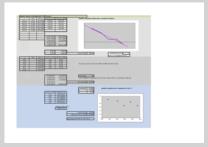
NavList:
A Community Devoted to the Preservation and Practice of Celestial Navigation and Other Methods of Traditional Wayfinding
From: Jaap vd Heide
Date: 2012 Jan 28, 16:04 -0800
Dear Peter,
I am still making a little progress (I think) and you are right it would have been better stating delta_x and delta_y.
The point of development in my thinking in my previous postings I was only trying to fit based on the intermediate (what I dubbed "supporting") point.
For getting a better result (fix) in the "Daytime Jupiter Ex-Meridian/ M.P. /LOP Exercise" I am now experimenting with "subtracting" the known linear value-trend ["a" can be calculated from an estimation of L and knowledge of d].
In the ideal world, after subtracting the trend, all the points should be on a straight horizontal line, "b". If there are errors, the y' values are all a little different.
That leaves you with the simple task of averaging the residue.
(Which at this point have become straightforward values, so averaging just means adding them all up and dividing by the number of values -> voila, "b")
I attach a pdf print of the excel sheet I am doing my testing with. The example has 7 observations, which do not line up cleanly. And just like as in the excel sheet I attached yesterday (the 11:29 posting), it has the option to add some extra random errors, to see what happens.
(the testing errors are introduced in C2:C8 and can be controlled by altering the value in M18)
What's new in the sheet as it is at the moment is making a first estimation of "a" and with that of the shape of the parabola. But working with its 1st differential.
Now just before I read your message, I was going through the discussion "lat/lon from meridian passage" about a year ago.
From that I have another idea: besides subtracting the linear trend it should be possible to just add or subtract a value from all values in the differentiated graph, to compensate for (1) change of d of the heavenly body over the period within the sights are taken and (2) the N-S component of the speed of a moving vessel. The E-W component of the speed of a moving vessel should be compensated by means of a first estimate of L and the prior determined value of "a", transposing the E-W component of the speed of the vessel into meridian arc.
I will keep you all posted! ;-)
Regards,
Jaap
----------------------------------------------------------------
NavList message boards and member settings: www.fer3.com/NavList
Members may optionally receive posts by email.
To cancel email delivery, send a message to NoMail[at]fer3.com
----------------------------------------------------------------







